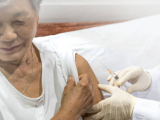May 31, 2012 (CIDRAP News) – As health officials take stock of a 2011-12 flu season that was lighter and later than usual, flu vaccine makers are releasing production estimates that add up to a somewhat lower total than the early estimate at this time a year ago.
Tom Skinner, a spokesman for the US Centers for Disease Control and Prevention (CDC), said that on the basis of company projections, the total number of doses is expected to range from 146 million to 149 million for the 2012-13 flu season.
Last year at this time, the early projection was between 166 million and 173 million doses. According to the CDC's final flu vaccine report for the 2011-12 season, posted in early February, companies actually distributed 132.1 million doses.
Representatives from flu vaccine companies were on hand at the National Influenza Vaccine Summit (NIVS) in the middle of May to update health officials on their vaccines and production estimates.
Early estimates from company sources reached by CIDRAP News and in presentations posted on the NIVS site from the five companies making flu vaccine for the US market include:
- Sanofi Pasteur: about 65 million doses
- Novartis: 32 million to 35 million doses
- GlaxoSmithKline (GSK): 25 million to 28 million doses
- MedImmune:13 million to 14 million doses
- Merck, which markets and distributes CSL's flu vaccine: 13 million doses
Flu vaccine production is notoriously unpredictable, as problems can arise anywhere in the production cycle, from vaccine-virus growth to packaging. In February, an advisory group to the World Health Organization (WHO) recommended changing two of the three flu strains in the vaccine, which followed two seasons in which all three strains remained the same.
The two-strain change could create some production glitches, but flu vaccine makers contacted by CIDRAP News say production is going smoothly.
Tor Constantino, MBA, director of product public relations for MedImmune, said the projection for FluMist doses is slightly lower than last year's production. He said the company is uncertain how the light and late flu season just past will affect demand for the next season's vaccine.
If production continues to go smoothly, MedImmune expects to start shipping in late July or early August, he said.
Elizabeth Power, a spokeswoman for Novartis, said the company's projection is above the more than 27 million doses produced last year and reflects an increase in customer demand.
Donna Cary, director of public relations for Sanofi Pasteur, said the amount the company expects to make this year is about the same as last season, though the company will be providing a different mix of products, now that the intradermal flu vaccine and high-dose vaccine for seniors are more widely available.
The Fluzone intradermal vaccine was licensed late last year, with a limited supply available later in the season. Cary said Sanofi's goal last year was to give healthcare providers a chance to try the vaccine. Company surveys suggest that 94% of patients were satisfied with it, and 67% said they preferred it over the intramuscular vaccine, she added.
"Of course, this was in a population already getting immunized who presumably were not adverse to IM vaccination," she said, adding that Sanofi believes the intradermal vaccine has the potential to boost flu immunization rates in the18- to 64-year-old age group.
The company's surveys also got positive responses from providers, who listed ease of use as the top reason for satisfaction, Cary said.
Meanwhile, the high-dose vaccine for seniors just finished its first full season of use, and, according to Sanofi's data, went into the arms of about 12% of people over age 65 who received their flu vaccine, Cary said, who described the uptake as good for the vaccine's first year. Sanofi has had a strong level of advance orders for the upcoming season, and the high-dose vaccine should be available for any senior who wants it, she said.
So far there have been no problems related to the strain change, and the company expects to begin shipping in July after the Food and Drug Administration licenses the new formulation and releases the lots, Cary said.
According to the NIVS presentations, Merck estimates that shipments of CSL flu vaccine will begin in August and be completed in October, Glaxo expects shipping to begin as early as late July and end in October, and Novartis expects shipping to begin in early to mid August and continue through October.
This year's flu vaccination season will begin a little less than a year after a widely noted meta-analysis raised questions about the effectiveness of standard flu vaccines. The strict meta-analysis of high-quality randomized controlled trials, published in Lancet Infectious Diseases last October, put seasonal flu vaccine efficacy at 59% for adults younger than 65, which was lower than commonly cited 70% to 90% estimates.
Despite this, the authors said existing vaccines are the best weapons for protection against flu and should be used until more effective ones are available.
See also:
CDC report on total flu vaccine doses distributed
May 11, 2011, CIDRAP News story "Record flu vaccine production expected again this year"
NIVS 2012 meeting presentations


















